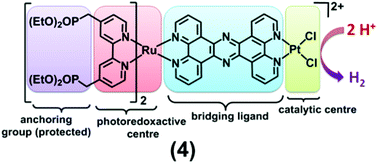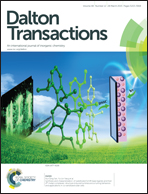Synthesis and characterization of an immobilizable photochemical molecular device for H2-generation†
Abstract
With [RuII(bpyMeP)2tpphzPtCl2]2+ (4) a molecular photocatalyst has been synthesized for visible-light-driven H2-evolution. It contains the ligand bpyMeP (4,4′-bis(diethyl-(methylene)-phosphonate)-2,2′-bipyridine) with phosphate ester groups as precursors for the highly potent phosphonate anchoring groups, which can be utilized for immobilization of the catalyst on metal–oxide semiconductor surfaces. The synthesis was optimized with regard to high yields, bpyMeP was fully characterized and a solid-state structure could be obtained. Photophysical studies showed that the photophysical properties and the localization of the excited states are not altered compared to similar Ru-complexes without anchoring group precursors. (4) was even more active in homogenous catalysis experiments than [RuII(tbbpy)2tpphzPtCl2]2+ (6) with tbbpy (4,4′-bis(tbutyl)-2,2′-bipyridine) as peripheral ligands. After hydrolysis (4) was successfully immobilized on NiO, suggesting that an application in photoelectrosynthesis cells is feasible.


 Please wait while we load your content...
Please wait while we load your content...